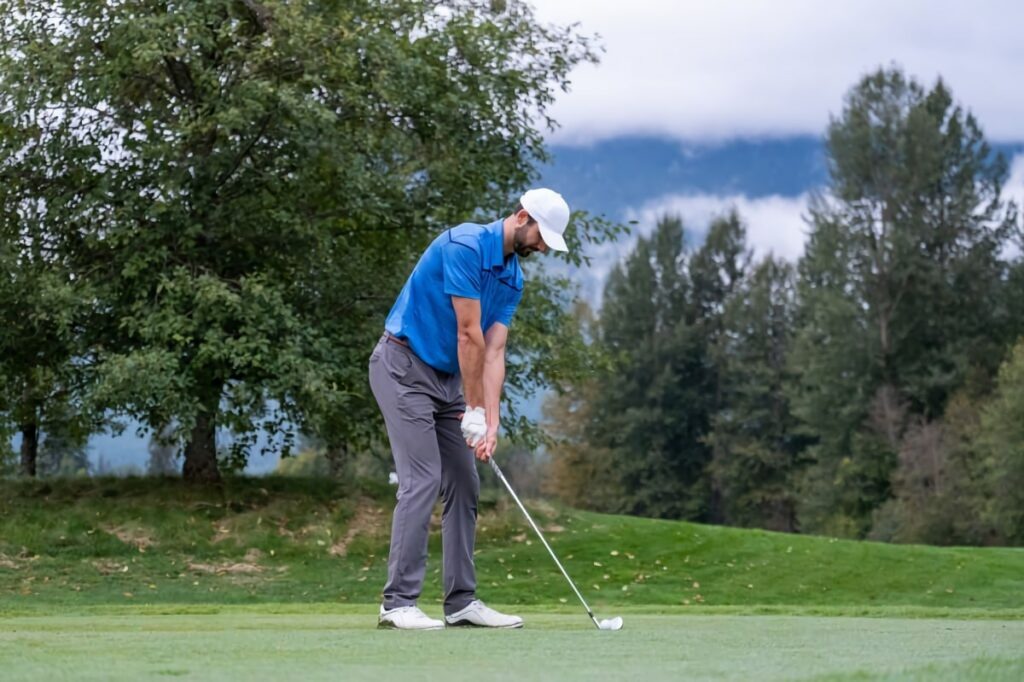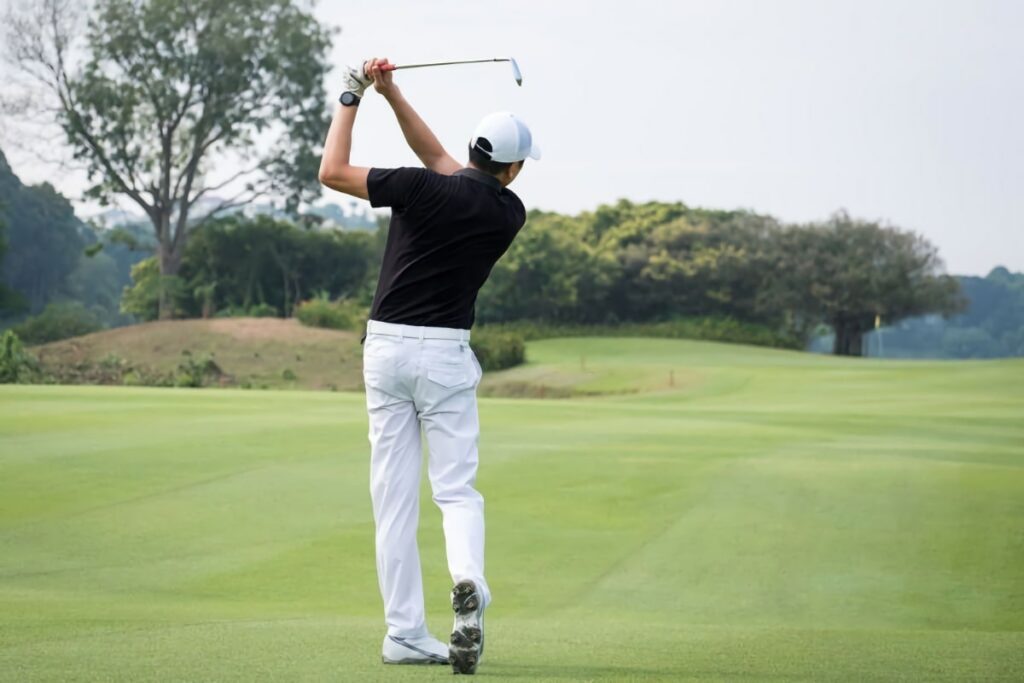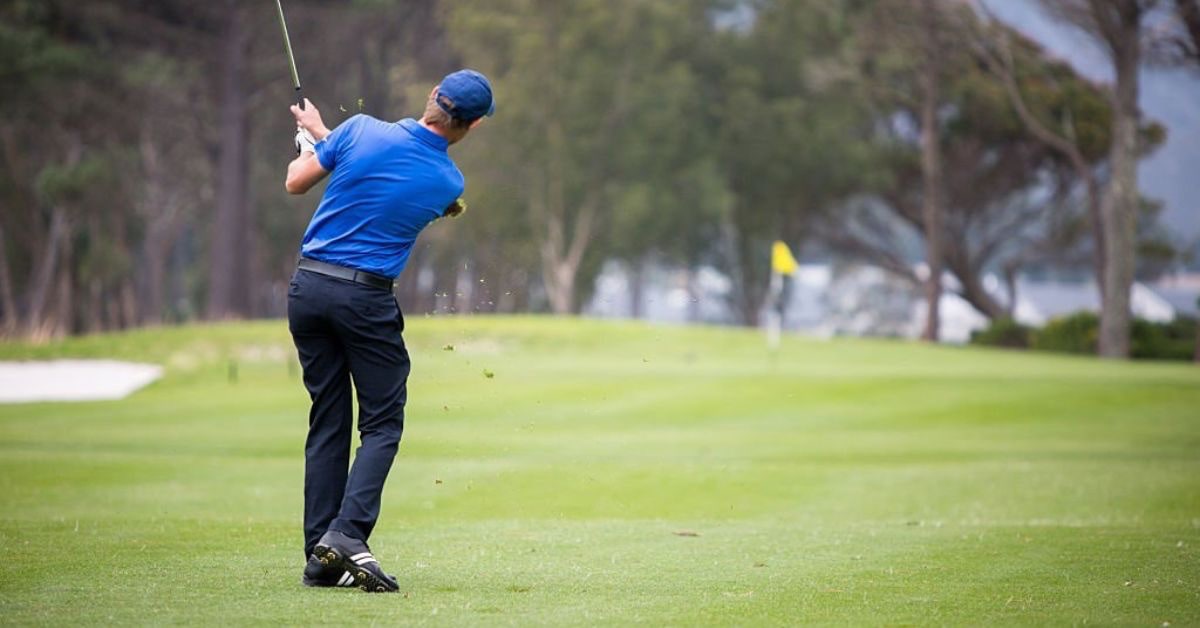Many things make great golfers great. One of those things is having exceptional control of their wedges. To score well in golf, you need to limit the number of shots it takes you to get up and down from inside 100 yards.
Today, I wanted to share some tips on how to control your wedges better and, importantly, how to flight the shots you hit into greens from 50 to 100 yards.
Topics to be covered include the following:
- What is a flighted golf shot & what are the benefits?
- Step-by-step guide on how to flight wedges
Let’s dive into it!
“Golf isn’t just about hitting a lot of drivers. I grew up playing on my front lawn, chipping, and putting into soup cans, out of the ivy and over rose bushes and hedges. I just loved having a wedge in my hands.”
LPGA Legend Amy Alcott
What is a Flighted Golf Shot?
To start today’s discussion, let’s define a “flighted” golf shot.
A flighted golf shot is one where the golfer tries to control the shot’s launch and spin. Having this ability is essential in a golfer’s wedge play.
With the more lofted clubs, such as your wedges, your main goal is to get the ball close to the hole. It’s not about how far you can hit your wedges but how accurate you can be to set yourself up for a shorter putt.
When you can control the launch with your wedges, you take some of the variables out — such as wind — which can hugely affect the outcome of your shot.
Additionally, if you can control your launch, you can also control your spin. This is a trait we see many of the best players in the world possess.
There are plenty of things that the professionals on the PGA and LPGA Tour do that leave us in awe. They hit massive towering drives, have incredible accuracy with their irons, and have a can’t-miss-putting stroke…
But there is just something about those low, one-hop-and-stop wedge shots that we love. Or how about those low little zippers that take two hops and spin back several feet close to the pin? Those shots are magical and fun to watch.
How to Flight Wedges
There are a few basics to remember when learning how to flight wedges.
Additionally, there are some non-technique-based factors that you need to consider to maximize the results you get flighting your wedges.
The following are some steps to help you master the flighted wedge shot.
Step 1: Pre-Technique
First and foremost, it’s important to understand that these types of wedge shots are exclusively target and accuracy based.
There is a need for speed in your swing (which I will get to in a bit), but the most critical non-technical aspect to becoming a good wedge player is understanding, precisely, how far your target and landing spots are from you.
So, with this in mind, here are some pre-technique tips to be aware of:
- Get your exact yardage to the pin.
- Get an understanding of the terrain and slopes of the green. This can be done through a greens book, some apps, or by looking at and studying the green.
- Get an understanding of the environmental conditions such as wind and temperature. These both will play a mjor factor in planning and outcomes. Also, if you can gauge how dry or damp the greens are, that will also help. Wetter greens will spin more, and firmer greens will release more.
- Have a clear understanding of any hazards around the green to avoid.
- With all of the above-gathered information, make your best educated guess for your ideal landing spot and the ideal trajectory needed for the shot.
- Even when practicing, aim for an exact point and have an end target in mind.
“With wedges, your goal is to have a consistent amount of power, not maximum power.”
Rickie Fowler via Golf Digest
Step 2: The Setup
For your pre-shot setup, follow these tips:
- Set your ball position slightly back of center.
- Have a stance that is a little narrower than for a regular shot.
- Open your stance, feet only, and keep your shoulders square.
- Your pressure will be set forward, with as much as 70% on your lead side, and your center mass will be over the ball. This means having your chest over the ball with more pressure being felt into your lead foot.
- Medium grip pressure is recommended. Not too light and not too tight.

Step 3: The Backswing
In your backswing, you’ll want to feel the following:
- As you go back, you want to feel like your body is driving the backswing. Your arms and club will stay in front of you as you turn back. It is not a big turn, like in a full swing, but there is indeed body rotation.
- Limit your wrist hinge as you go back. You may have heard the term “dead hands” from some of the great wedge players like Steve Stricker, Zach Johnson, and Tiger Woods. This is precisely what they mean — limiting that wrist hinge and having some width as you take the club back.
- Your pressure will stay forward into your lead foot, but your weight, or center mass, will remain centered over the ball.
- Do not overswing. Have a feeling of being precise with your hand position at the top of your backswing. You can imagine your swing length like the hands on a clock. Based on how far your shot needs to be, you will swing back to 9:00, 10:00, 11:00, etc., to help control your distance.
“Some players who maybe aren’t quite as visual feel it more 50, 75, 90 percent. I’m a little bit more in that fashion, but find what’s right for you.”
Parker McLachlin via Golf.com
Step 4: The Downswing
In your downswing, you will want to feel the following:
- As you transition down from the top, you want to get the club a little shallower. To do this, you must feel like your hands and the club is getting behind you slightly.
- You will need to feel your body rotating on the way down and on through impact. That is important.
- Tempo is critical in these shots, as in all golf shots. Your tempo will vary slightly based on the shot’s distance and the wedge loft you use. However, the recommended ratio is anywhere between 2:1 and 3:1, meaning your downswing must be between two to three times as fast as your backswing.
“Tempo is the glue that sticks all elements of the golf swing together.”
Sir Nick Faldo
Step 5: Impact & Follow-Through
As you move into impact through to your finish, aim to feel the following:
- You will want to have the shaft leaning at impact BUT approaching the ball shallower than you would in a standard shot.
- The body should rotate hard to the lead side, and your hands and club will exit low and left (for righties). You need speed in this shot, even though it is a shorter shot. Decelerating is the kiss of death for shots like this.
- Your center mass and pressure will be fully transferred to the lead side.
- Hold the finish with your hands in a lower finish position than would be the case with more standard shots.
“Through research, Dr. Rob Neal, a world-renowned Biomechanist and the founder of WedgeCraft, says that the best-flighted wedge players on tour launch shots at about 30 degrees in order to produce a low launching, high spinning shot.”
Devan Bonebrake, Host of Golf Channel’s The Golf Fix
Other Considerations for Flighting Wedges
There are other things to consider in dialing in your wedge play, and more specifically, these all-important flighted wedge shots.
Equipment is one of those things to consider.
You’ll want to have the best wedges in your hands to help optimize your outcomes. Make sure they have a good design with good spin properties built into the face.
Also, you’ll need to get the correct bounce configuration for your game. Some golfers are more prone to be a little steeper coming into the ball, and others a little shallower. The bounce on the club’s sole should match up with your unique swing.
Your wedge gapping is important as well. This is usually more preference-based, however, ensuring you have enough wedges in your bag for different distance shots without any significant gaps in between is very important.
The most popular gapping is 4 degrees of loft between your wedges.
Finally, the last piece of equipment to consider is the ball you use. Try and use a ball that matches your game but also has good spin capabilities. Good golf balls and wedges are essential parts of the equation in being a good wedge player.

Final Thoughts
Shots from 100 yards and in make up a staggering 60% of all the shots you will hit in a round of golf, regardless of your ability level and what scores you shoot.
Of that 60%, putting makes up a part of that for sure, but it leaves a considerable percentage of shots being taken with a lofted wedge in your hand.
Wedges are your true scoring clubs, and shots inside 100 yards are undoubtedly some of the most important for golfers of any ability.
To score better, you must know how to play your wedges. Understanding how to flight your wedges is part of becoming a better player overall.


